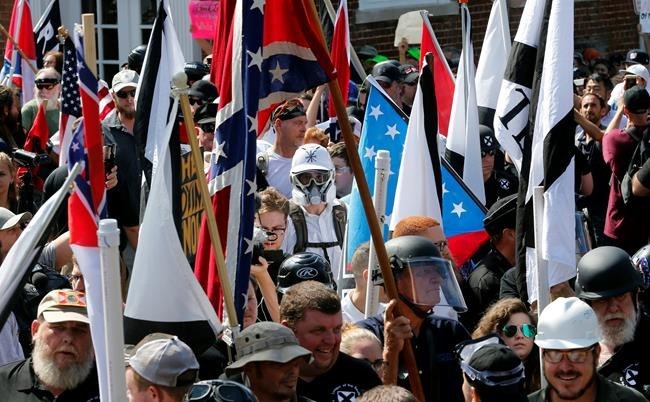
FILE - In this Saturday, Aug. 12, 2017, file photo, white nationalist demonstrators walk into the entrance of Lee Park surrounded by counter demonstrators in Charlottesville, Va. A former federal prosecutor says the law enforcement response to a white nationalist rally this summer in Charlottesville that erupted in violence was a series of failures. The findings of former U.S. Attorney Tim Heaphy's monthslong investigation were unveiled Friday, Dec. 1. City officials asked him to conduct the review after facing scathing criticism over the Aug. 12 rally.(AP Photo/Steve Helber, File)
Republished December 06, 2017 - 2:55 PM
Original Publication Date December 06, 2017 - 10:51 AM
RICHMOND, Va. - A report on Virginia's response to a violent white nationalist rally this summer in Charlottesville found some missteps by law enforcement, including a "chaotic scene" in a joint command centre and little "on-the-ground collaboration" between agencies.
The after-action review prepared by the International Association of Chiefs of Police is the second independent report released this month on the deadly Aug. 12 rally. Some of this report's findings overlap with the blistering, much longer report by former U.S. Attorney Tim Heaphy, who conducted a review for the city. But the most recent report is generally far less critical of the state's response.
"Without the presence of such a large, well-trained, well-equipped contingent of state assets and close, collaborative planning between entities, arguably the outcome of the event could have been far worse," the state's report says.
Charlottesville became a target for white nationalists after the city council voted to remove a statue of Confederate Gen. Robert E. Lee from a downtown park. After several smaller rallies, hundreds of white nationalists and counterprotesters converged downtown on Aug. 12.
Fighting broke out before the event officially began, and the brawling went on for around an hour in front of officers until an unlawful assembly was declared and the crowd was forced to disband. Later, as counterdemonstrators were peacefully marching through a downtown street, a car drove into the crowd, killing 32-year-old Heather Heyer and injuring many more.
Plans for the reviews were announced shortly after the rally amid anger and scrutiny from residents and activists over what many perceived as an overly restrained response by authorities as the violence unfolded. So far, no disciplinary actions have been announced as a result.
The IACP team that conducted the review interviewed more than 30 people involved in "various stages of the state's response," the report says. The team travelled to Richmond and Charlottesville three times and conducted a walkthrough of the site. It reviewed video, operational plans, news reports and other materials and also interviewed officials in other states about their responses to similar rallies.
The state provided "ample resources" and conducted "thorough preparation" ahead of the rally, the report said.
"During interviews, city officials spoke very highly of the support they received from the Commonwealth, in particular from the Virginia State Police. Cooperation among all parties throughout the planning stage was excellent," it says.
Heaphy's report, by contrast, characterized police planning as "inadequate and disconnected."
Both reports acknowledge that state and city police had separate operational plans, including different guidance on when to make arrests. However, they describe the resulting problems in far different terms.
"Despite ongoing communication and collaboration between VSP and CPD," the fact that they didn't sort out the rules of engagement led to "hesitation and the appearance of inaction in the field," the state report says. It also says there was "little on-the-ground collaboration."
Heaphy's report says law enforcement "elevated officer safety over public safety" and "failed to maintain order and protect citizens from harm, injury, and death."
This latest report emphasizes that the Charlottesville Police Department was the lead agency and state police played a supporting role.
It says city officials did not heed advice from high-ranking state officials including Gov. Terry McAuliffe ahead of the event. Those suggestions included that the event permit require protesters to be bussed in, and to prohibit firearms, even though Virginia law does not allow authorities to do this.
"The activity at Emancipation Park could have been contained had these recommendations been heeded," it says.
Like Heaphy's report, the state's also notes communication problems the day of the event. State and city police couldn't communicate by radio, which lead to information having to be relayed two to three times, the state report says.
Interviews also suggest "a chaotic scene" in the unified command centre, the state report says, adding that not all "key personnel" were in the building.
McAuliffe's spokesman, Brian Coy, said there is "a lot to learn" from both reviews.
"This is not really an exercise in blame-placing. This is just a matter of finding out what went well and what went wrong and doing better in the future," he said.
A report from a task force the governor convened was released along with the IACP's review. It makes 16 recommendations, including modifying Virginia code to allow localities to prohibit firearms at permitted events.
All the reports point to the need for better co-operation and co-ordination, Charlottesville spokeswoman Miriam Dickler said.
"We look forward to working with our partners at the state level to better respond to future events," she said in a statement.
Charlottesville police didn't comment. A Virginia State Police internal after-action review is ongoing, spokeswoman Corinne Geller said. She noted that they prepared for weeks in partnership with other state and local agencies for "a multitude of worst-case scenarios," and ultimately made the largest deployment of personnel and resources in the agency's 85-year history.
News from © The Associated Press, 2017